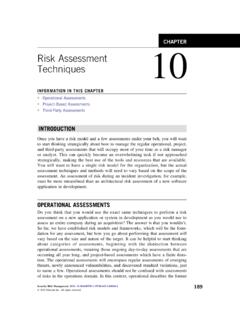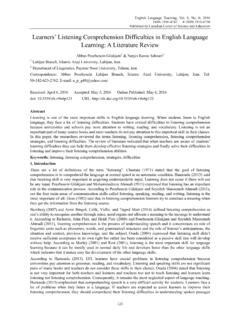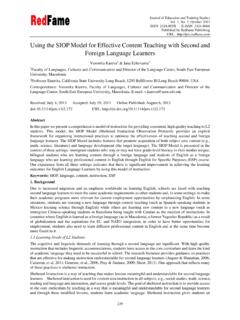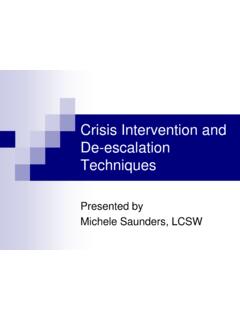Transcription of Interpersonal Psychotherapy: Techniques, supervision
1 Interpersonal psychotherapy : Techniques, supervisionChristopher GaleAdvanced Trainees24th May 2007 Outline What is Interpersonal therapy? Why use Interpersonal therapy? supervision of practice. Working with is IPT Interpersonal psychotherapy (IPT) is a brief and highly structured manual based psychotherapy that addresses Interpersonal issues in depression, to the exclusion of all other foci of clinical attention. This approach has allowed ready modification of the original treatment manual for depression to a variety of illnesses. isIPT web is a partial model of depression IPT emphasizes these depressive symptoms occur within an Interpersonal context that is often interdependent with the illness process.
2 Depression is conceptualized by IPT as having three components Symptom Formation Social Functioning PersonalityThe four areas of social dysfunction Patient's social functioning problems are conceptualized as one or more of four areas:- Interpersonal Disputes Role Transitions Grief Interpersonal Deficits Interpersonal Disputes These tend to occur in marital, family, social or work settings. A situation in which the patient and other parties have diverging expectations of a situation and that this conflict is excessive enough to lead to significant distress.
3 One example may be a marital dispute in which a wife's attempts to use initiative leads to conflict with her spouse. would aim to define how intractable the dispute was, identify sources of misunderstanding via faulty communication and invalid or unreasonable expectations and the aim to intervene by communication training, problem solving or other techniques that aim to facilitate change in the situation. Role Transitions Role transitions are situations in which the patient has to adapt to a change in life circumstances. These may be developmental crises, adjustments in work or social settings or adaptations following life events or relationship dissolutions.
4 In those who develop depression, these transitions are experienced as losses and hence contribute to the development of psychopathology. IPT aims to help the patient to reappraise the old and new roles, to identify sources of difficulty in the new role and fashion solutions for these. In many cases clarification of inconsistencies or clear errors in the patient's cognitions as well as problem solving and encouragement of affect within the therapeutic frame are suitable Grief is simply defined in IPT as "loss through death". In IPT the term is reserved specifically for bereavement.
5 If grief is formulated as an issue of relevance the assumption is that the grieving process has been complicated by delay or in many cases excess. The therapist will help to reconstruct the patient's relationship with the deceased and by encouraging affect as well as clarification and empathic listening help facilitate the mourning process with the aim of helping the patient to establish new Deficits A patient reports impoverished Interpersonal relationships in terms of both number and quality of the relationships described. In many cases the Interpersonal inventory will be sparse and the patient and therapist will need to focus upon both old relationships as well as the relationship with the therapist.
6 In the former common themes should be identified and linked to current circumstances. The therapist aims to identify problematic processes occurring such as excess dependency or hostility and aim to modify these within the therapeutic frame. In this way the therapeutic relationship can serve as a template for further relationships which the therapist will aim to help the patient create. This group of problems is common in the more chronic affective disorders such a dysthymia in which significant degrees of social impoverishment have occurred either before or after the to offer Interpersonal therapy.
7 When one has the infrastructure to support this therapy. Ability to offer weekly sessions. Peer supervision or tele- supervision . When there are clear role conflicts, transitions and/or grief experiences with the patient. [If Interpersonal deficits alone, consider a cognitive or Interpersonal approach].Structure and Duration of Sessions 12 to 16 one hour sessions that usually occur weekly. The initial sessions are devoted to information gathering and clarifying the nature of the patient's illness and Interpersonal experience. The patient's illness is then formulated and explained in Interpersonal terms and the nature and structure of the IPT sessions are explained.
8 This phase of treatment concludes with the composition of the " Interpersonal inventory" which is essentially a register of all the key relationships in the individual's life. Sessions 3 - 14 are devoted to addressing the problematic relationship areas and there is little focus upon the specific illness process apart from enquiries as to symptom severity and response to treatment modalities. The final sessions 15 - 16 focus upon termination, which is usually formulated as a loss experience. Assessment. Should IPT be used. Attachment style Communication style Specific qualities useful for IPTA ttachment and communication Relationship style.
9 All persons in life quality of relationships between persons. When ill, When distressed Attachment Past relationships. Loss, grief Patient's perception of IPT be used? Does the therapist want to work with patient? Patient open-ness to discuss painful events. Beginning therapeutic alliance. Quality of patient's narrative. compelling, meaningful, coherent. non-compelling, little meaning, poor coherence Quality of attachment to others. Secure, anxious-ambivalent, qualities. Less severe illness. Good motivation. Ready ability to form therapeutic alliance.
10 Good ego strength Psychological contract (in IPT, always written). Number, frequency, duration therapy. Agreed clinical foci. Expectations patient, therapist. Contingency planning Missed sessions. Illness, holidays. Treatment inventory Bill (Husband) Married 6 years Wanted a baby, talked about it before she got pregnant Used to communicate well, seemed committed Problems Won't talk Gets angry when confronted (NB she reports v. hostile interactions) Won't contribute Seems to hide @ work. Expectations Wants him to keep his word (be a father) Equal time Less hostile Communication style Seems not co tcommunicate the point clearly Problem solving Previously Biological Familial Substance misuse Illnesses Effect medications.








